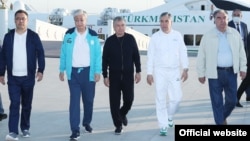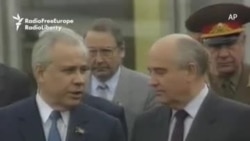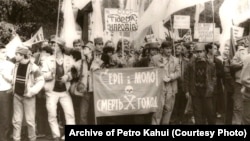
It was all smiles and handshakes at Turkmenistan’s Caspian resort area of Awaza on August 6 when leaders of the five former Soviet republics in Central Asian gathered for a summit. But it has taken some 30 years to reach that point.
As Kazakhstan, Kyrgyzstan, Tajikistan, Turkmenistan, and Uzbekistan mark their 30th anniversaries of independence, they almost certainly have better regional ties than at any point since the collapse of the Soviet Union in 1991.
The meeting in Awaza was the third recent Central Asia summit. Although a proposed summit in 2020 was cancelled in 2020 due to the coronavirus pandemic, there were similar meetings in the Kazakh capital, Astana, in 2018 and in the Uzbek capital, Tashkent, in 2019.
Before that, it had been nearly 20 years since the presidents of all five countries gathered together in a forum of their own without the presence of other foreign leaders.
That fact hints at how turbulent their ties have been during the course of 30 years.
Unity should have been easy, or at least, easier than it has proven to be.
When the Belovezha Accords were signed on December 8, 1991 -- formally ending the existence of the Soviet Union and creating the Commonwealth of Independent States (CIS) -- none of the signatories were leaders of Central Asian former Soviet republics.
Kazakhstan’s Nursultan Nazarbaev was invited but did not attend. Technically, Kazakhstan was the last Soviet republic for eight days because there was no formal declaration of independence from Kazakhstan until December 16.
The leaders of Kazakhstan, Kyrgyzstan, Tajikistan, Turkmenistan, and Uzbekistan all met in Ashgabat -- then called Ashkhabad -- on December 13, 1991 and agreed to join the CIS. But in truth, they had little choice.
They were not heroes of a revolution. They had not been lobbying for independence. Most of them had, at best, sat on fence while the attempted Kremlin coup of August 1991 unfolded in Moscow and set the stage for the demise of the Soviet Union.
All five were Kremlin appointees. Making matters worse, the Kremlin-appointed leader of Tajikistan, Qahhor Makhamov, had been chased from office for supporting the coup.
Rahmon Nabiev, who attended the meeting in Ashgabat, was already Tajikistan's third president since independence.
And suddenly, instead of carrying out Kremlin orders as they had under the Soviet system, Central Asia's leaders had to govern their countries without any guidance from Moscow.
Pledges of cooperation made in Ashgabat in late 1991 quickly fell apart as the new realities of governing set in -- the need to bring in revenue as well as the necessity to import vital food and energy supplies.
Under the Soviet unified energy grid, Uzbekistan had supplied natural gas to Kyrgyzstan, to Tajikistan, and to southern Kazakhstan. But suddenly, Tashkent wanted money for its gas and none of those countries had the funds.
All were using the Russian ruble as their currency during the first years of independence. But hyperinflation was constantly driving down the value of the ruble.
That created a situation where money earned in rubles had to be spent immediately. That made it nearly impossible to meet budget goals.
When Kyrgyzstan became the first of the five to introduce its own national currency in May 1993, its Central Asian neighbors were angered and feared they would become dumping zones for Russian rubles.
Uzbekistan turned off the natural gas supply to Kyrgyzstan in retaliation, a tactic Tashkent would also use against Tajikistan. Officially, supply cuts were the result of unpaid bills.
But the timing of the cuts too often coincided with policy moves in Kyrgyzstan and Tajikistan that Uzbekistan found objectionable.
All the Central Asian states experienced economic crises for most of the 1990s with shortages of basic goods, heating, and electricity.
That led to a competition among them to attract foreign investors. Every Central Asian state was anxious to sell whatever commodities it possessed in the hope of bringing in fresh revenue and turning their economies around.
WATCH: The Coup That Killed The U.S.S.R.
Civil war broke out in Tajikistan in the spring of 1992. For the first time, there were border problems.
Uzbekistan closed its border with Tajikistan -- a step no one had considered before. Not long after, Uzbekistan started setting up checkpoints at all its borders with its newly independent neighbors in Central Asia.
Each of those states did the same, in turn, thereby creating an added expense to already meager state budgets and slowing the transit of goods.
Economic Union
There also were attempts at cooperation in the early years of independence.
Kazakhstan, Kyrgyzstan, and Uzbekistan agreed to contribute troops to a peacekeeping force that Russia established for Tajikistan. Their mission was to guard the Afghan border -- allowing Tajikistan’s government forces to focus on fighting their battlefield opponents.
Kazakhstan, Kyrgyzstan, and Uzbekistan also formed an economic union in 1994. The presidents of the three countries -- Nazarbaev, Kyrgyzstan’s Askar Akaev, and Uzbekistan’s Islam Karimov -- met often in the early years of independence to sign “eternal” friendship treaties and map out a future all could share.
However, Turkmen President Saparmurat Niyazov chose a different course. Not long after independence, his country became increasingly separate from the rest of Central Asia. Niyazov did not show any interest in joining any Central Asian organizations.
After 1995, when the United Nations recognized Turkmenistan as a neutral state, Niyazov withdrew cooperation with the other Central Asian countries almost entirely.
Tajikistan’s civil war was viewed as a possible contagion for the rest of the region.
When Emomali Rahmon emerged as Tajikistan's leader in November 1992, he was long viewed as governing a country in chaos -- even after the civil war ended in 1997.
Tajikistan was excluded from most attempts to bolster Central Asian unity.
It was only in March 1998 that Tajikistan gained admission to the Central Asian Customs Union -- a group comprised entirely of Central Asian states.
But not long after the United States and its allies announced their war against terrorism in neighboring Afghanistan, such purely Central Asian organizations were displaced by larger multilateral groups like the Shanghai Cooperation Organization and the Collective Security Treaty Organization.
Terror Threat
The first post-Soviet act of terrorism in Central Asia was on February 16, 1999, when a series of bombings was carried out in Tashkent.
In the summer of that year, the presence of the Islamic Movement of Uzbekistan (IMU) extremists in southern Kyrgyzstan drove more wedges between the Central Asian states.
The Uzbek government blamed Tajikistan for allowing the IMU militants to use Tajik territory as a base -- a charge Tajik authorities denied. Uzbekistan's government also blamed Kyrgyzstan for not making a greater effort to eliminate the militants.
It was in that tense diplomatic environment that Uzbekistan began to lay land mines along its borders with Kyrgyzstan and Tajikistan in 2000, saying it was necessary to hinder infiltrations by IMU militants.
But the only reported casualties from those mines were civilians in Kyrgyzstan and Tajikistan. Civilian land-mine casualties continued to rise for many years after the IMU had ceased to be an immediate threat to Central Asia.
Tajik authorities accused Uzbekistan of supporting an attempted coup in northern Tajikistan in November 1998.
Turkmenistan refrained from publicly accusing Uzbekistan of being behind an alleged assassination attempt on President Niyazov in November 2002.
But Turkmen security forces did search the Uzbek Embassy in Ashgabat and declared Uzbek Ambassador Abdurashid Kadyrov persona non grata less than one month after the alleged attempt on Niyazov’s life.
The Tulip Revolution in Kyrgyzstan that ousted President Akaev in March 2005 was cheered by some as a victory for democracy.
But it was seen as an unwelcome development by other Central Asian governments. They were concerned that popular unrest might also lead to the overthrow of leaders like Nazarbaev, Niyazov, and Karimov who had been in power since the start of independence.
Subsequent ousters of Kyrgyz presidents in 2010 and 2020 have simply reinforced the concerns of other Central Asian leaders about Kyrgyzstan’s stability, and about the bad precedent Kyrgyzstan’s popular uprisings could become for their countries.
Twenty years after independence, the five Central Asian countries were already noticeably different from one another. All were a long way from the five orphan countries whose leaders had hoped at the December 1991 Ashgabat summit for their common history to foster cooperation and help all become prosperous states.
There was not much common ground left and it was perhaps not surprising that the leaders did not meet often, even for bilateral visits.
In the best cases, it was difficult to cross the borders from one country into another. In the worst cases, the borders were closed.
The death of Uzbek President Karimov in late summer 2016 proved a catalyst for improving regional relations.
Karimov had always been antagonistic toward other Central Asian leaders At various times, his undiplomatic candor in front of microphones seemed to be aimed at offending Nazarbaev, Akaev, Rahmon, Niyazov, and Kyrgyzstan’s president from 2011-2017, Almazbek Atambaev.
Karimov’s successor, Shavkat Mirziyoev, has fallen short so far on many of his domestic reform plans. But his pledge to improve Uzbekistan's ties with its Central Asian neighbors is coming true.
The recent Central Asia summits are examples of the idea that Central Asian cooperation is possible again.
To be sure, problems remain. An ongoing border dispute between Kyrgyzstan and Tajikistan is, by far, the most serious.
But even after the two countries were involved in a brief conflict at the end of April, both leaders were in Awaza.
Mirziyoev and the current Kazakh president, Qasym-Zhomart Toqaev, have been meeting and speaking individually with Kyrgyzstan's new president, Sadyr Japarov. Tajik President Rahmon has made efforts to cool tensions along the Kyrgyz-Tajik frontier.
Turkmenistan continues to be an outlier, but the other four have cooperated during the pandemic and tried to help each other when they could.
The borders are not all totally open. But they are more open than they have been for more than 20 years. And the land mines have been cleared from Uzbekistan’s borders with Kyrgyzstan and Tajikistan.
The recent summits have focused on connectivity that should link all of the Central Asian economies together more closely.
Kyrgyzstan is the first to celebrate the 30th anniversary of Independence Day on August 31. It is followed by Uzbekistan on September 1, Tajikistan on September 9, Turkmenistan on September 27, and Kazakhstan on December 16.
Ironically, one of the best things about Independence Day this year in the five former Soviet republics of Central Asia may be their ability to cooperate and depend upon each other more than previously possible.













